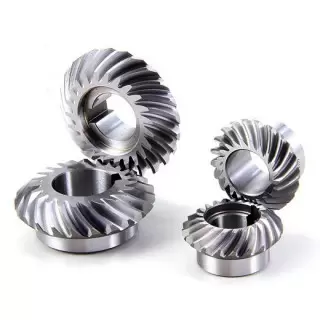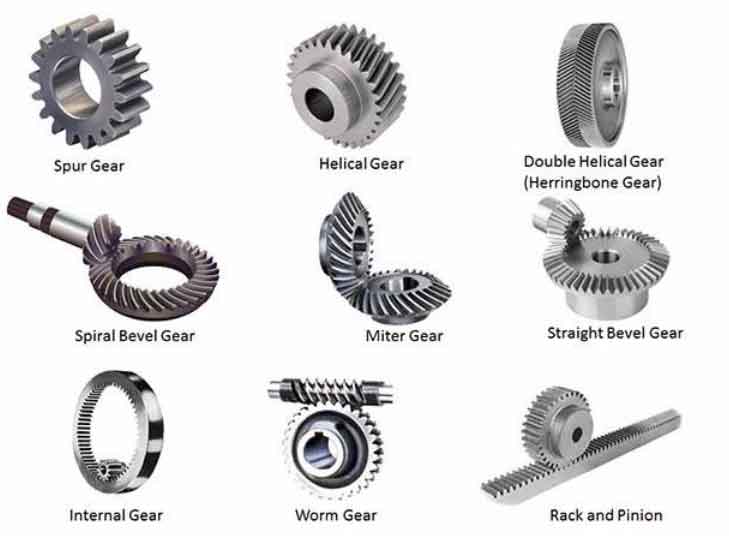Product Description
| Name: | Bevel Gear |
| Material: | 45 Steel |
| Product model: | 4M/5M/6M |
| Quenching treatment: | High frequency of tooth surface |
| MOQ: | 1 |
| Speed Ratio: | 1:1 |
| High strength: | Yes |
| Long Life: | Yes |
| Flat tooth gear pinion: Materail(carbon steel,copper,42Crm,plastics,stailness steel,Aluminum,iron) |
| 0.1Mod,0.2Mod,0.3Mod,0.4Mod,0.5Mod,0.6Mod,0.7Mod,0.8Mod,0.9Mod1Mod,1.5Mod,1.25Mod,2Mod,2.5Mod,3Mod,3.5Mod,4Mod,5Mod,6Mod,7Mod,8Mod,9Mod,10Mod |
| 11Mod,12Mod,13Mod,14Mod,15Mod,16Mod,17Mod,18Mod,19Mod,20Mod |
| Spur with step tooth gear pinion: Materail(carbon steel,copper,42Crm,plastics,stailness steel,Aluminum,iron) |
| 0.1Mod,0.2Mod,0.3Mod,0.4Mod,0.5Mod,0.6Mod,0.7Mod,0.8Mod,0.9Mod1Mod,1.5Mod,1.25Mod,2Mod,2.5Mod,3Mod,3.5Mod,4Mod,5Mod,6Mod,7Mod,8Mod,9Mod,10Mod |
| 11Mod,12Mod,13Mod,14Mod,15Mod,16Mod,17Mod,18Mod,19Mod,20Mod |
| Left Helical Flat tooth gear pinion: Materail(carbon steel,copper,42Crm,plastics,stailness steel,Aluminum,iron) |
| 0.1Mod,0.2Mod,0.3Mod,0.4Mod,0.5Mod,0.6Mod,0.7Mod,0.8Mod,0.9Mod1Mod,1.5Mod,1.25Mod,2Mod,2.5Mod,3Mod,3.5Mod,4Mod,5Mod,6Mod,7Mod,8Mod,9Mod,10Mod |
| 11Mod,12Mod,13Mod,14Mod,15Mod,16Mod,17Mod,18Mod,19Mod,20Mod |
| Left Helical Spur with step tooth gear pinion: Materail(carbon steel,copper,42Crm,plastics,stailness steel,Aluminum,iron) |
| 0.1Mod,0.2Mod,0.3Mod,0.4Mod,0.5Mod,0.6Mod,0.7Mod,0.8Mod,0.9Mod1Mod,1.5Mod,1.25Mod,2Mod,2.5Mod,3Mod,3.5Mod,4Mod,5Mod,6Mod,7Mod,8Mod,9Mod,10Mod |
| 11Mod,12Mod,13Mod,14Mod,15Mod,16Mod,17Mod,18Mod,19Mod,20Mod |
| Right Helical Flat tooth gear pinion: Materail(carbon steel,copper,42Crm,plastics,stailness steel,Aluminum,iron) |
| 0.1Mod,0.2Mod,0.3Mod,0.4Mod,0.5Mod,0.6Mod,0.7Mod,0.8Mod,0.9Mod1Mod,1.5Mod,1.25Mod,2Mod,2.5Mod,3Mod,3.5Mod,4Mod,5Mod,6Mod,7Mod,8Mod,9Mod,10Mod |
| 11Mod,12Mod,13Mod,14Mod,15Mod,16Mod,17Mod,18Mod,19Mod,20Mod |
| Right Helical Spur with step tooth gear pinion: Materail(carbon steel,copper,42Crm,plastics,stailness steel,Aluminum,iron) |
| 0.1Mod,0.2Mod,0.3Mod,0.4Mod,0.5Mod,0.6Mod,0.7Mod,0.8Mod,0.9Mod1Mod,1.5Mod,1.25Mod,2Mod,2.5Mod,3Mod,3.5Mod,4Mod,5Mod,6Mod,7Mod,8Mod,9Mod,10Mod |
| 11Mod,12Mod,13Mod,14Mod,15Mod,16Mod,17Mod,18Mod,19Mod,20Mod |
| Bevel Gear : Materail(carbon steel,copper,42Crm,plastics,stailness steel,Aluminum,iron) |
| 0.1Mod,0.2Mod,0.3Mod,0.4Mod,0.5Mod,0.6Mod,0.7Mod,0.8Mod,0.9Mod1Mod,1.5Mod,1.25Mod,2Mod,2.5Mod,3Mod,3.5Mod,4Mod,5Mod,6Mod,7Mod,8Mod,9Mod,10Mod |
| 11Mod,12Mod,13Mod,14Mod,15Mod,16Mod,17Mod,18Mod,19Mod,20Mod |
| Helical Bevel Gear : Materail(carbon steel,copper,42Crm,plastics,stailness steel,Aluminum,iron) |
| 0.1Mod,0.2Mod,0.3Mod,0.4Mod,0.5Mod,0.6Mod,0.7Mod,0.8Mod,0.9Mod1Mod,1.5Mod,1.25Mod,2Mod,2.5Mod,3Mod,3.5Mod,4Mod,5Mod,6Mod,7Mod,8Mod,9Mod,10Mod |
| 11Mod,12Mod,13Mod,14Mod,15Mod,16Mod,17Mod,18Mod,19Mod,20Mod |
Product Description
/* January 22, 2571 19:08:37 */!function(){function s(e,r){var a,o={};try{e&&e.split(“,”).forEach(function(e,t){e&&(a=e.match(/(.*?):(.*)$/))&&1
| Application: | Motor, Electric Cars, Motorcycle, Machinery, Marine, Toy, Agricultural Machinery, Car |
|---|---|
| Hardness: | Hardened Tooth Surface |
| Gear Position: | External Gear |
| Samples: |
US$ 14/Piece
1 Piece(Min.Order) | Order Sample |
|---|
| Customization: |
Available
| Customized Request |
|---|
.shipping-cost-tm .tm-status-off{background: none;padding:0;color: #1470cc}
|
Shipping Cost:
Estimated freight per unit. |
about shipping cost and estimated delivery time. |
|---|
| Payment Method: |
|
|---|---|
|
Initial Payment Full Payment |
| Currency: | US$ |
|---|
| Return&refunds: | You can apply for a refund up to 30 days after receipt of the products. |
|---|

What lubrication and maintenance practices are required for spiral gears?
Spiral gears require proper lubrication and maintenance to ensure optimal performance and longevity. Here are the recommended lubrication and maintenance practices for spiral gears:
- Lubrication: Adequate lubrication is essential for smooth gear operation and to minimize wear. The lubricant forms a protective film between the gear teeth, reducing friction and preventing metal-to-metal contact. It is crucial to use a lubricant that is compatible with the gear material, operating conditions, and load requirements. Regular lubrication intervals should be followed, and the lubricant should be replenished as needed.
- Lubricant Selection: The selection of the lubricant depends on various factors such as gear speed, load, temperature, and environment. It is recommended to consult the gear manufacturer or lubrication experts to determine the most suitable lubricant for the specific application. The lubricant should have appropriate viscosity, additives, and temperature resistance to provide effective lubrication and protect against wear and corrosion.
- Lubricant Application: The lubricant should be applied evenly to the gear teeth and mating surfaces. Depending on the gear design and accessibility, lubrication can be done through oil bath immersion, oil splash, forced circulation, or grease application. It is important to follow the gear manufacturer’s guidelines or industry best practices for proper lubricant application.
- Monitoring and Inspection: Regular monitoring and inspection of the gear condition are essential for early detection of any abnormalities or signs of wear. This can include visual inspections, checking for unusual noise or vibrations, and measuring gear backlash and tooth wear. Monitoring can help identify potential issues and allow for timely maintenance or lubricant adjustments before significant damage occurs.
- Cleaning and Contaminant Control: Regular cleaning of the gears and their surrounding areas is necessary to remove dirt, debris, and contaminants that can affect gear performance and lubrication. Contaminants can accelerate wear and cause damage to the gear teeth. Proper sealing and contamination control measures should be implemented to minimize the ingress of contaminants into the gear system.
- Maintenance Schedule: Establishing a maintenance schedule is important to ensure timely lubricant replenishment, gear inspections, and necessary repairs or replacements. The maintenance schedule should consider the operating conditions, gear load, and manufacturer’s recommendations. Adhering to a well-planned maintenance schedule helps prolong the service life of spiral gears and ensures their continued performance.
By following these lubrication and maintenance practices, spiral gears can maintain their efficiency, durability, and reliability over time. Regular attention to lubrication, monitoring, and maintenance contributes to the smooth operation and extended lifespan of spiral gears in various applications.

What are the benefits of using spiral gears in high-torque applications?
Spiral gears, also known as helical gears, offer several benefits when used in high-torque applications. These advantages make them well-suited for transmitting large amounts of torque efficiently and reliably. Here are the key benefits of using spiral gears in high-torque applications:
- High Load Capacity: Spiral gears are designed to handle high loads and transmit significant amounts of torque. The helical tooth arrangement allows for load distribution across multiple teeth, reducing stress concentration on individual teeth. This design feature enables spiral gears to withstand the heavy forces encountered in high-torque applications.
- Smooth and Efficient Power Transmission: The helical shape of the teeth in spiral gears enables smooth and continuous contact between the mating gears. This gradual tooth engagement results in reduced impact and vibration during gear meshing. Additionally, the helical tooth profile minimizes sliding friction, leading to efficient power transmission and reduced energy losses, which is particularly important in high-torque applications where power efficiency is crucial.
- Reduced Noise and Vibration: The gradual tooth engagement and improved contact pattern in spiral gears contribute to reduced noise and vibration during operation. The helical tooth arrangement helps to distribute the load more evenly, minimizing dynamic forces and resulting in quieter gear operation. This is especially beneficial in high-torque applications where noise reduction is desired, such as precision machinery or noise-sensitive environments.
- Axial Thrust Compensation: Spiral gears can be designed with opposite helix angles on mating gears, which helps cancel out the axial thrust generated during gear meshing. This feature is particularly advantageous in high-torque applications where managing axial forces is critical. By eliminating or reducing the axial thrust, spiral gears simplify the gear design and reduce the need for additional components, such as thrust bearings.
- Reliability and Durability: The robust design of spiral gears, combined with their ability to handle high loads and transmit torque efficiently, contributes to their overall reliability and durability in high-torque applications. The gradual tooth engagement, load distribution, and reduced friction help minimize wear and extend the service life of the gears, ensuring long-term performance under demanding conditions.
These benefits make spiral gears an excellent choice for high-torque applications where reliable and efficient power transmission, smooth operation, reduced noise, and durability are essential requirements.

What are spiral gears and how are they used in machinery?
Spiral gears are a type of cylindrical gears with teeth that are curved in a spiral pattern. Unlike straight-cut gears, which have teeth that are parallel to the gear axis, spiral gears have teeth that are angled or helical. This helical tooth arrangement provides several advantages in terms of performance and noise reduction.
Spiral gears are commonly used in machinery for various applications due to the following reasons:
- Smooth and Quiet Operation: The helical tooth arrangement of spiral gears enables gradual tooth engagement, resulting in smoother and quieter operation compared to straight-cut gears. The angled teeth allow for gradual contact, reducing noise and vibration during gear meshing.
- Increased Load Capacity: The helical tooth design of spiral gears distributes the load over multiple teeth, increasing the load-carrying capacity. This makes spiral gears suitable for applications that require high torque transmission and heavy-duty operations.
- Improved Efficiency: The helical tooth arrangement of spiral gears helps in minimizing sliding friction between the teeth. This results in a higher level of efficiency compared to straight-cut gears, as there is reduced power loss due to friction during gear operation.
- Axial Thrust Compensation: Spiral gears can be designed with opposite helix angles on mating gears, which helps in canceling out the axial thrust generated during gear meshing. This feature eliminates the need for additional thrust bearings, simplifying the gear design and reducing complexity.
- Versatility: Spiral gears can be manufactured in various configurations, including spur, helical, and double helical designs. This versatility allows for their application in a wide range of machinery, including automotive systems, industrial equipment, and power transmission systems.
In machinery, spiral gears are commonly used in applications that require smooth operation, high load capacity, and efficient power transmission. Some examples include gearboxes, automotive differentials, machine tools, and heavy-duty industrial machinery.
Overall, the unique tooth geometry of spiral gears makes them a preferred choice in many machinery applications, offering improved performance, reduced noise, and enhanced load-carrying capabilities.


editor by CX 2024-04-09